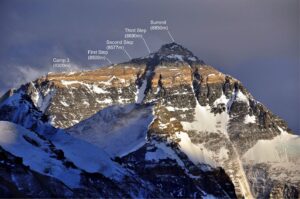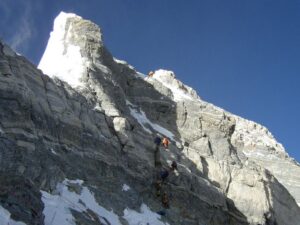For people who like adventure stories, no unsolved mountaineering mystery is more famous, fascinating, or enduring than the question of whether George Leigh Mallory and Andrew Irvine summited Mount Everest on June 8, 1924.
This expedition attempted to climb the mountain from the Tibetan side, as Nepal was closed to outsiders until after World War 2. The final route to the summit on the northeast ridge involves climbing three rock steps (first photo below; read details here). (Note: Due to foreshortening, the mountainside looks steeper in the photo than it is.)
They were seen by Noel Odell at 12:50 pm through a break in the mists, from a position at about 25,900 feet, far above an moving upward. Odell was never entirely sure which rock step they were on, but initially believed he saw them climb the second step (28,250 feet), although later conceded it may have been the first step (28,097 feet). He was more than 2,000 feet below them, and well over half a mile away by line of sight, so they appeared to him as only tiny dots and he saw them only momentarily before the mists closed in again.
Mallory’s body was found 75 years later, in 1999, at 26,768 feet. He was tied to a broken rope, and had injuries consistent with a fall that must have occurred during descent. Irvine’s ice axe was found in 1933 at 27,760 feet, about 1,000 feet above and 100 meters (330 feet) off to the side of Mallory’s body, i.e. near but not in the apparent fall line (bottom photo). Irvine is still missing. (There are unconfirmed stories of Chinese climbers finding his body.) An oxygen bottle from 1924 was found in 1999 just below the first step, and there’s no physical evidence of their presence higher.
The second step is shown in the second and third photos below. The ladders and fixed ropes weren’t there in 1924, or in 1960 when this difficult obstacle was surmounted by a Chinese party of three by standing on each other’s shoulders (described here). Mallory was a rock climber, but Irvine was not, and in any case they couldn’t have climbed it in 5 minutes as Odell described so he most likely watched them climb the first step. (For a contrary opinion, watch video here.)
Entire books have been written on this subject by people who’ve climbed the route. I can only go on descriptions, photos, and logic. Sentimentalists would like to believe they made it, but I think that’s very far-fetched. They were hours behind schedule, the oxygen equipment of that time was unreliable, and the second step was too difficult. They may have reached it and turned around there. In any case, should a climb count if you don’t make it back down alive?
(Click on photos to enlarge)



